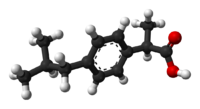
Photo from wikipedia
Background Previous studies suggested that phospholipase Cβ3 (PLCβ3), which is a common downstream component in the signaling cascade, plays an important role in peripheral mechanisms of perception including nociception. However,… Click to show full abstract
Background Previous studies suggested that phospholipase Cβ3 (PLCβ3), which is a common downstream component in the signaling cascade, plays an important role in peripheral mechanisms of perception including nociception. However, detailed profiles of PLCβ3-expressing dorsal root ganglion (DRG) neurons and involvement of PLCβ3 in inflammatory and postoperative pain have not been fully investigated. Purpose We evaluated neurochemical char0acteristics of PLCβ3-expressing DRG neurons in mice and then we examined the effects of selective knockdown of PLCβ3 expression in DRGs on inflammatory and postoperative pain. Methods Male C57BL/6-strain mice were used. For the inflammatory model, each mouse received subcutaneous injection of complete Freund’s adjuvant (CFA) in the left hindpaw. For the postoperative pain model, a plantar incision was made in the left hindpaw. PLCβ3 antisense oligodeoxynucleotide or PLCβ3 mismatch oligodeoxynucleotide was intrathecally administered once a day for three consecutive days in each model. The time courses of thermal hyperalgesia and mechanical hyperalgesia were investigated. Changes in PLCβ3 protein levels in DRGs were evaluated by Western blotting. Results Immunohistochemical analysis showed that high proportion of the PLCβ3-positive profiles were biotinylated isolectin B4-positive or transient receptor potential vanilloid subfamily 1-positive. PLCβ3 protein level in DRGs during CFA-induced inflammation was comparable to that at baseline. Intrathecal administration of PLCβ3 antisense oligodeoxynucleotide, which significantly suppressed PLCβ3 expression in DRGs, did not affect pain thresholds in normal conditions but inhibited CFA-induced thermal and mechanical hyperalgesia both at the early and late phases compared to that in mismatch oligodeoxynucleotide-treated mice. Intrathecal administration of PLCβ3 antisense oligodeoxynucleotide also inhibited surgical incision-induced thermal and mechanical hyperalgesia. Conclusion Our results uncover a unique role of PLCβ3 in the development and maintenance of inflammatory pain induced by CFA application and in those of surgical incision-induced pain, although PLCβ3 does not play a major role in thermal nociception or mechanical nociception in normal conditions.
Journal Title: Journal of Pain Research
Year Published: 2020
Link to full text (if available)
Share on Social Media: Sign Up to like & get
recommendations!